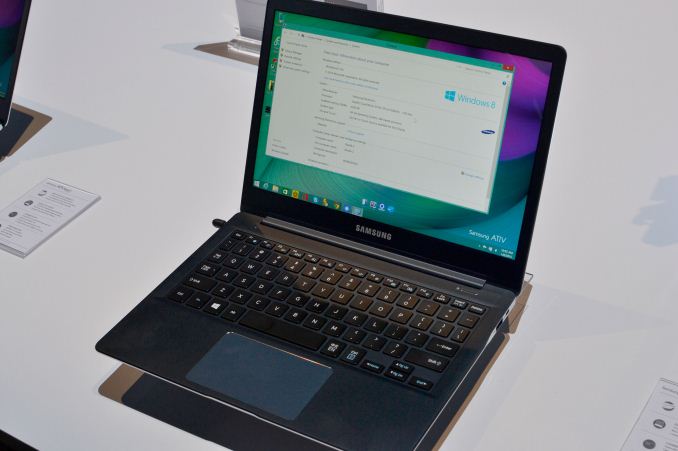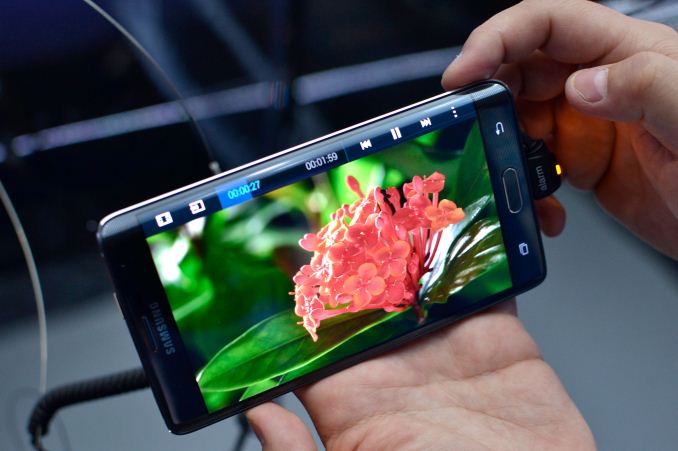Samsung CES Booth Tour: Tablets, Phones, and Core M ATIV Book 9
by Jarred Walton on January 19, 2015 2:41 PM EST- Posted in
- Laptops
- Samsung
- Smartphones
- Mobile
- Tablets
- Trade Shows
- ATIV
- Ultrabook
- Core M
- CES 2015
_678x452.jpg)
Perhaps the most interesting aspect of Samsung’s booth is what they weren’t showing: laptops. They had exactly one laptop on display, the new ATIV Book 9 with Core M-5Y10c – that’s the configurable TDP “c” variant of Core M, which allows the manufacturer to target different power levels. In the case of the 5Y10c, it can target 3.5W and 6W as well as the default 4.5W, allowing for lower performance but potentially increased battery life (or at least less heat) on the one hand, and higher performance but more heat (and potentially less battery life) on the other. On paper, the configurable TDP mostly affects the base frequency, with the default being 800MHz and TDP down dropping that to 600MHz while TDP up bumps it to 1GHz – the maximum Turbo Boost remains 2GHz in all modes, as far as I’m aware – but for sustained workloads the TDP should also affect what Turbo clock the CPU is able to maintain.
The laptop itself is quite sleek, with hints of the MacBook Air school of design, and Samsung is boasting of battery life of up to 12.5 hours. Connectivity consists of two USB 3.0 ports (one with sleep charging), a headset jack, a micro-SD slot, and one micro-HDMI port. The display is also a nice looking 2560x1600 panel – yes, that’s a 16:10 resolution for a change – which is the same display used in the Samsung Galaxy Tab/Note Pro 12.2. I have to admit that it’s still rather frustrating that other than Apple, all laptops are generally now on 16:9 aspect ratio displays while most tablets remain at 16:10, but I digress. The latest ATIV Book 9 should be shipping soon (it’s listed as preorder/out of stock on at least a few sites), with pricing of $1399 for 8GB RAM and a 256GB SSD.
The remainder of the Samsung booth was mostly products that have already launched, with a lot of tablets and phones on display. There were a few non-US phones (the A5 and A3), and the Galaxy Note Edge that has an OLED with the curved right side ostensibly used for notifications and other items that looks interesting but may not be particularly practical. The Galaxy Tab S tablets were also present, along with the ruggedized and waterproof Galaxy Tab Active. Of course it was fun to ask the booth attendants about the hardware only to be told “we’re not making that information public yet” – particularly unhelpful since the products are already on store shelves. The Tab Active is equipped with a Snapdragon 400 if you’re wondering, so it’s more about being rugged than performance, and the price as usual for ruggedized products is quite high.
Of course Samsung had a ton of other products on display, including displays, HDTVs, All-in-One PCs, and more, but our primary focus was on the above categories for this CES.
Source: Samsung




_thumb.jpg)
_thumb.jpg)
_thumb.jpg)
_thumb.jpg)
_thumb.jpg)
_thumb.jpg)








45 Comments
View All Comments
Owls - Monday, January 19, 2015 - link
Is it an Apple product? Then no.kenansadhu - Tuesday, January 20, 2015 - link
@owls wateanazag - Monday, January 19, 2015 - link
I love 16x10. Much better than 16x9. It needs to be the default. I doubt we'll see that because computer makers suck at predicting a market.My two work monitors are 1680x1050. Could they have a higher resolution? Of course.
I had a Dell Latitude D810 with a 15.6" 1680x1050 (X600 ATI doing the ~heavy lifting). I miss the screen. The rest of the laptop is ancient now, but it was a good choice at the time. I was very happy with that laptop while I had it.
I find this laptop interesting, but I would want a discrete GPU. In some ways it defeats the purpose, but with a resolution like that I would want to game on it.
SleepyFE - Monday, January 19, 2015 - link
16x10 is back to basics. It's very close to 4x3 which is old. A laptop can fit a wider keyboard if it's 16x9 and there is less wasted space for the handrests. Your hands aren't bigger than a 16x9 laptop can fit. Also 1920x1080 is a standard that will be supported for a loooooooooong time and it is in 16x9 ratio. So I am not happy they are making 16x10 monitors, as it is not standard and forces people to argue about what is better. If manufacturers just stuck with 16x9 things would be cheaper by the dozen.Solandri - Monday, January 19, 2015 - link
When you get to these especially small/light devices, 16:10 gives greater internal volume pound for pound than 16:9. 3:2 gives even more. It's simply the way geometry works - maximum volume for minimum surface area in a flat object would be a square. The more rectangular you make it, the greater the surface area (for a constant volume), and the heavier the device.Klug4Pres - Tuesday, January 20, 2015 - link
Plaudits for Samsung for releasing a taller display than 9:16. I would prefer 2:3 or 3:4, but it's a good sign that another manufacturer has produced a modern machine without the accursed 16:9 "shortscreen" letterbox.JarredWalton - Tuesday, January 20, 2015 - link
The thing is, the only reason they're likely doing 16:10 is that they can use the display from the Galaxy Tab/Note Pro 12.2 -- they made the display for tablets and are using it in a laptop, not the other way around. Until/unless I see 13.3" and larger displays in laptops that aren't from Apple, I won't believe we're going to reverse the 16:9 trend. As Brett said recently, "that ship has mostly sailed."Klug4Pres - Wednesday, January 21, 2015 - link
Jarred, you are depressing me now, but I see your point. Maybe someone will build a 14 inch 4:3 ips tablet and re-use some screens for a laptop!Tams80 - Tuesday, January 20, 2015 - link
16:9 becomes less usable the smaller the display gets (until you reach phone territory).16:9 displays already dominate the market. I doubt stopping the already limited production of 16:10 displays would make any noticeable difference on 16:9 display prices. Display companies still need to make a profit.
fokka - Tuesday, January 20, 2015 - link
if all you do on your laptop is watch tv shows in 16:9, then yes, 1080p/16:9 might be a perfect fit. for everything else though 16:10 is superior.if you're watching a movie in cinemascope you'll have big ugly bars on 16:9 too, they're just a little bigger on 16:10. but once you start your browser, or dare to edit a document or excel sheet, it's just more handy to have a little more vertical breathing room and require a little less scrolling throughout your day.
you'll also find relatively huge bezels on many laptops with 16:9 screens, simply going with a 16:10 screen would help tremendously in many cases.
so the only thing that is an advantage of 16:9 is the cost, because display manufacturers somehow thought it was a good idea to convert to 16:9 only, no matter if the panels are for TVs, computer monitors or laptops.